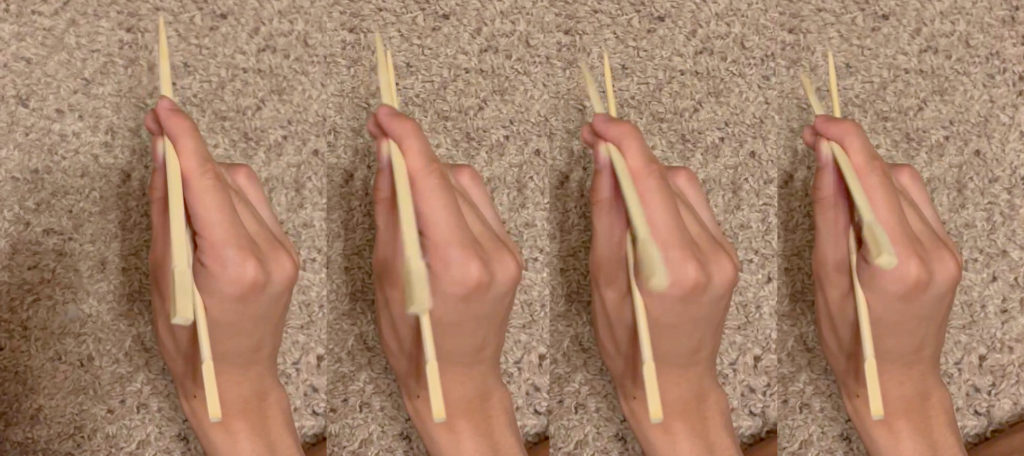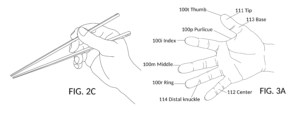This is a first article in a new series called “Why Can’t I Chopstick“. In the last few years, we have been monitoring discussions on the r/chopsticks subreddit. A few common issues surface from time to time. Some of these are in fact already addressed by our existing articles in the Physics of Chopsticks category. But new and unanswered questions have also been asked. The “Why Can’t I Chopstick” series will answer these new questions.
One common problem mentioned by learners of Standard Grip has to do with tips of chopsticks. Specifically, a practitioner is unable to make tips of the two chopsticks come together. He or she can extend chopsticks apart from each other. But when bringing them together to pinch food, they are unable to make chopstick tips meet. Instead, tips swing past each other by a wide margin, as following videos show.
This article is brought to you, courtesy of u/iiRaz0r from Reddit. Video clips and pictures demonstrating this pinching issue come from u/iiRaz0r.
內容目錄
Compared to proper Standard Grip
A chopstick physicist once made this remark:
All happy Standard Grips are alike, but every unhappy Standard Grip is unhappy in its own way.
a chopstick physicist
A happy Standard Grip follows all details described in our Learn to Use Chopsticks article. This includes the tripod hold, the 1-on-2-support, the twirling of the top chopstick, the Caswellian thumb pose, and more. Most lifelong Standard Grip practitioners have long acquired all of these skills over a period of time by trial and error, even if none of them can articulate why they are essential to Standard Grip.

For an adult learner of Standard Grip, however, your goal is to master it as fast as you can. But not all of these required skills can be mastered quickly nor at the same time. In fact, a sizable population cannot actually wield the Caswellian thumb pose required by Standard Grip, due to anatomical reasons, as we discussed in the Caswellian article, and in The Art and Science of Chopsticking. For most adult learners, even after you understand Standard Grip intellectually, it mail still take time for you to build up muscle strength, in order to wield Standard Grip properly and efficiently.
As the earlier quote clarifies, each unhappy Standard Grip is unhappy in its own way. A proper Standard Grip moves chopsticks in such a way that their tips meet at the closed posture. If you can’t make tips pinch together, then you are wielding an unhappy Standard Grip, in your own unhappy ways. Assuming that you don’t have anatomical constraints, this article will discuss various common causes that prevent you from making tips of chopsticks meet.
We’ll start by comparing one particular unhappy grip shown below left, to the happy one shown below right. Both pictures show practitioners extending chopsticks apart, at the open posture. What differences do you see, between the two pictures?

In both pictures above, practitioners hold chopsticks mid-stick. This is not what we usually recommend. We usually recommend holding chopsticks aft-stick. But as discussed in Out with the Crossed Type, in with the Under Swing, finger placement along the length of chopsticks is not a problem that needs fixing, but rather a personal preference. In this article, we show Standard Grip being held mid-stick, for the sake of matching the unhappy ones in appearance, for easier visual comparison.
Here we have the unhappy grip compared to the happy one, at the closed posture. What differences between the two do you see?

Lack of cantilever extension
As explained in Planetary gears: physics of chopsticks, the twirling of the top chopstick enables the hand to securely grasp the top chopstick as an extension of fingers. It allows an entire finger to exert forces on the stick, not just at one Archimedean “effort point”, but on a large area of chopstick surface. There is not a single fulcrum. But instead, an entire finger surface from another finger serves as counter force to securely cage and sandwich the chopstick, turning it into a cantilever extension of fingers.

We’ll have more to say about this planetary gears principle and the twirling motion later. For now, we just want to highlight how an unhappy Standard Grip often does not evidence a strong cantilever extension. This can be seen below, where the unhappy grip on the left shows barely any contact surfaces between the top chopstick and the hand. In contrast, the happy grip on the right shows extensive skin contact with the top chopstick.


Here is a top view of an unhappy grip, showing a lack of cantilever extension.

Focus on where the rear of the top chopstick rests in pictures shown below.
To fix this issue, bring the rear of the top chopstick closer to the base of the index finger. Pictures shown below mark a red dot on the rear of the top chopstick. At the open posture, this red dot should be found at the base of the index finger marked by a yellow arrow.

Similarly ensure that the rear of the top chopstick remains close to the base of the index finger, even at the closed posture.

When you attempt these fixes, you may find that while you can position the top chopstick according to the instruction, when you try to move from the open posture to the closed posture, you can’t keep the red dot at the base of the index finger. This is an indication that your unhappy grip suffers from a second issue, which we will discuss next.
Lack of air-quote twirling
As discussed in details in Learn to Use Chopsticks, the only way for the top chopstick to move with an expansive range is for fingers to roll it with an air-quote gesture. The GIF below left shows an exercise you can undertake, in order to appreciate how this motion works. Note how edges of the chopstick confirm that the top chopstick has been rolled for about 180°. Then practice an exaggerated version of Standard Grip as shown below right. Focus first on the open posture, and on orienting the top chopstick for a total incagement by the index finger and the middle finger. Make sure that your thumb pad meshes with the surface of the chopstick, and rolls the chopstick along, as index and middle fingers bring the chopstick down in an air quote gesture.
Rolling of the top chopstick can be better appreciated from a front view of the hand. Pay attention to the thumb tip and the thumb pad. Note how at the closed posture shown below left, the thumb pad is touching a flat face of the top chopstick. Then note how at the open posture shown below right, the thumb has rolled away, leaving the thumb tip touching a different flat face of the top chopstick.

Here are close-up pictures of the same. Note how the thumb tip appears to “move” across the surface of the stick. But in reality, it “meshes” with the surface as if it sported gear teeth. By meshing and locking onto stick surface, the thumb tip is able to roll the stick for 90° around its longitudinal axis. This 90° rolls can be clearly seen between the closed posture on the left, and the open posture on the right.
As shown, rolling of the top chopstick is how the hand and its fingers actually extend chopsticks open, and clamp them closed. But this is a counterintuitive concept. Most adult learners will intuitively attempt to apply the principle of third-class Archimedean lever to the top chopstick, and try to pry it down with index and middle fingers, against the thumb, as shown below. Note how the chopstick does not roll, and its flat face grinds against the thumb pad. This is evident, because the position of the chopstick remains unchanged with respect to the thumb pad, from the open posture (leftmost) through the closed posture (rightmost).

The image shown below left illustrates the same issue. At the open posture, the tips of chopsticks shown are already almost closed. This is due to the lack of a proper cantilever extension as discussed in the last section. So ignore this artifact. Instead, use this open posture image to remember where the top chopstick is, with respect to the thumb pad.

Note how the thumb pad remains in the same place on the top chopstick at the closed posture. This betrays the fact that the top chopstick hasn’t been rolled by the thumb.

In order to roll the top chopstick, all three fingers in the tripod hold must work together, as described in Learn to Use Chopsticks. They are: the thumb, the index finger, and the middle finger. In the unhappy grip shown above left, only the thumb and the index finger participated. Note how the middle finger has slacked off, when it should have propped up the top chopstick against both the thumb and the index finger, as shown above right.

You can fix this issue by raising the middle finger, so that the yellow arrow points at the red dot on the top chopstick. At the closed posture, aim to have the green dot on the middle finger rest on the ring finger, at where the blue arrow points.
Hyperextended thumb
Another cause is an hyperextended thumb. This is briefly discussed in Caswellian thumb and chopsticks. Following is an extreme example of a hyperextended thumb, a condition known as the hitchhiker’s thumb.
Folks with Hitchhiker’s thumb may in fact wield an enhanced Standard Grip, but only after a good amount of practice. In the beginning, hyperextended thumb may be more of a hindrance than enhancement, as evidenced below.

Hyperextended thumb (left) vs regular Caswellian thumb (right)
The issue is not limited to the top chopstick. The curvature of the hyperextended thumb tends to push the rear part of the bottom chopstick further into the crotch between the thumb base and the palm. This makes the 1-on-2-support for the bottom chopstick less stable. And it affects the angle of the bottom chopstick, making its tip pivot upward and outward, thus compounding the issue at hand, where tips can’t be made to meet.

Hyperextension is only an obstacle to be overcome, however. It is not necessary a blocker for learning Standard Grip.









